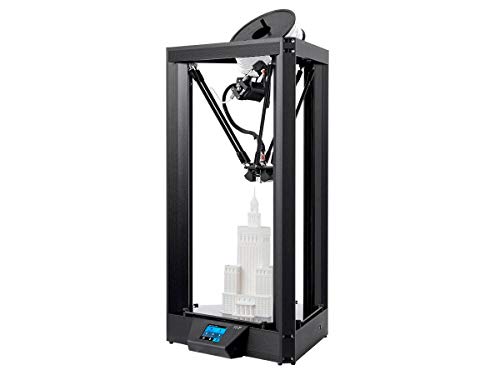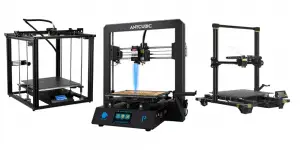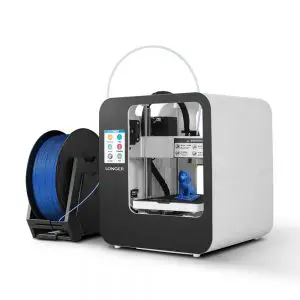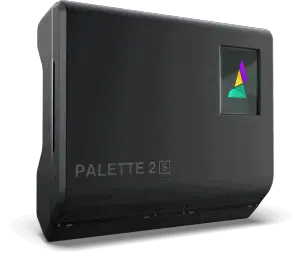If you’re in a hurry and just want to know what the best 3D printer for cosplay is, then we recommend the No products found. as the best one.
Creating Cool Cosplay is Better with a 3D Printer
Are you an avid LARPer? Perhaps you’re hitting the convention circuit or your local comic con. Maybe you simply love the art of creating your cosplay gear. No matter the reason you enjoy it, making armor and costumes can be done with finer details these days. All you need is a 3D printer to help. With so many on the market, it’s bound to be a difficult decision. So we’ve helped narrow down a few choices for you.
In this article we are going to review the following 3D printers:




Why Use a 3D Printer for Cosplay?
A needle and thread are great. Cutting out pieces of foam and manipulating plastic can give you the perfect look. Getting the exact pieces you need with precision down to the millimeter from a 3D printer is invaluable. However, there are certain things to consider before buying the perfect model for your needs.
What are you using it for?
In this area, size does matter. You could imagine yourself as a Storm Trooper and want a helmet printed off in one piece. You may want to craft a gold gauntlet to hold some infinity stones. Perhaps, you just want some heptagonal rivets to fasten to a breastplate of armor. There are a variety of cheap cosplay ideas you can play around with, but with the help of a printer, they won’t look cheap at all. You just have to keep in mind that the build spaces for printers differ. While one may be more expensive than another, the build size of the costlier machine may be too small to print your Warrior helmet.
Once you decide what your specific size needs are, you’ll need to consider the materials needed.
Texture, Flexibility, and Finish
To achieve the look of most designs from the Sci-Fi genre, you’ll want to use more exotic filaments outside of the standard PLA and ABS. Exotics like nylon, ceramic, metal, and wood will provide versatility and more stability to intricate builds but will require some more post-processing time. Metallic filaments will be better for 3D printed props that require glowing and metallic finishes like swords or cosplay helmets.
Technical Features & Exotic Filament
3D printers that can handle exotic filaments along with the standards, PLA and ABS, without too much difficulty will be a great accessory to print cool cosplay designs. Specs you’ll need to consider are the extruder and hot end, along with the print resolution and speed. The extruder will need to handle a variety of filaments with ease. The size of the hot end along with its temperature management will need to be considered. Filaments with differing properties each have their own settings to produce the best 3D printed cosplay designs.
How comfortable are you using a 3D printer and slicer software?
Last but not least, your budget may force you to choose between the less costly 3D printer DIY kits or the higher-priced plug and play models. It comes down to your comfort level. How much money are you comfortable spending on this endeavor? Better yet, how comfortable are you using 3D printers. Some come with assembly required after you purchase while others let you pull them right out of the box and get printing within minutes. The software needed to design your builds all have a range of expertise attached to them as well. You’ll want to consider how easy they are to use and learn. Of course, the longer you work with these printers and on cosplay designs
Now that you have a general idea of what size you need, your 3D printing experience coupled with the materials you’re looking to print with, we can take a look at a few models that can meet those needs.
Top 5 Contenders for the Best 3D Printer for Cosplay Props & Designs
Feel free to research these printers further, but the specs presented are the basics you need to know to make an informed decision. The features mentioned above will be taken into consideration as well with the following models.
Lulzbot TAZ 6
Technical Specifications
- Build volume – 280 mm x 280 mm x 250 mm
- Resolution – .050 mm to .50 mm
- Materials – PLA, HIPS, ABS, PVA, specialty filaments, PC-ABS, Nylon, UV luminescent filaments,PETG, conductive, Polycarbonate, PCTPE, etc.
- Ease of Use – Fairly easy to setup
The Lulzbot TAZ 6 is a high-end 3D printer with automatic bed leveling and untethered printing capabilities. The build area allows for larger prints with a variety of filaments to choose from. The software can be troublesome, but the printer is easy to use for the most part.
Pros
- Builds are reliable and consistent across filaments
- Large build volume
- Auto bed leveling
- Wide variety of acceptable filaments
Cons
- Noisy printing
- Lack of user control when the printer is untethered
- Slicer software can be complicated at times
Dremel Digilab 3D45
Technical Specifications
- Build volume – 254 mm x 152 mm x 170 mm
- Resolution – 50-300 microns
- Materials – PLA, Nylon, Eco-ABS, PETG
- Ease of Use – Easy for many enthusiasts to use
The Dremel Digilab 3D45 is a great printer for a higher price. It’s enclosed build area with carbon filters allows for minimized pollutants while printing with exotic filaments. This particular brand doesn’t print too well with 3rd-party filaments. It’s better to stick to the proprietary branded filaments and the quality will be stellar and consistent. There’s semi-automatic bed leveling and a fairly large build area, but it’s enclosed so your creativity and use of the space may be limited.
Pros
- large enclosed build area
- Easy to use
- Excellent build quality with Dremel branded filaments
Cons
- 3rd-party filaments don’t print well
- limited creativity with an enclosed build area
Monoprice Delta PRO
Technical Specifications
- Build volume – 270 mm diameter x 300 mm height
- Resolution – 50-300 microns
- Materials – PLA, Nylon, ABS, PETG
- Ease of Use – Plug and Play
The Monoprice Delta PRO is a plug and play 3D printer comes fully assembled with you only having to make sure the magnetic arms that move the hot end around are attached to the frame. There’s auto-calibration to get you printing within minutes of opening the package. The software can use some tweaking, but it gets the job done with PLA. Exotic filaments run into some issues, but the hot end is able to be swapped out so you can dial in the settings to better suit your build materials.
Pros
- Very large build area with high-quality consistency in larger prints
- Virtually no assembly required and easy to use right out of the box
- Prints great quality with PLA
Cons
- KisSlicer software can be cumbersome for beginners
- Exotic filaments don’t print with the same ease as PLA
- Struggles a bit with smaller prints
Monoprice Maker Select Plus
Technical Specifications
- Build volume – 200 mm x 200 mm x 200 mm
- Resolution – 100 – 400 microns
- Materials – PLA, ABS, Conductive PLA, Wood, Metal, Exotics, etc
- Ease of Use – Easy beyond leveling
This printer doesn’t come completely assembled. Being less expensive than the others on this list, there’s some tinkering around that needs to be done prior to your first build. First, you’ll need to adjust the bed manually. Once you’ve done this, you’re able to print with just about any filament you desire. Some additional parts such as Bowden tubing and hot ends should be purchased in addition if you’re a beginning enthusiast to 3D printed props. It can be easy to use once you’ve learned how to use it. That said, take advantage of the wealth of resources available for this printer as it can limit mistakes.
Pros
- Decent sized build area
- Quality prints with a large variety of exotic filaments and the standard PLA and ABS
- A large community of users along with tech support to help troubleshoot problems and ease usage
Cons
- Manual bed leveling can take some time to master
- There’s some assembly required
- It’s not the easiest to use right out of the box
No products found.
No products found.
No products found.
Technical Specifications
- Build volume – 300 mm x 300 mm x 400 mm
- Resolution – max is 100 microns
- Materials – PLA, ABS, TPU, Wood, Carbon fiber
- Ease of Use – Not for beginners
With manual bed leveling and a large build area, the No products found. has a lot of pros and not too many cons. The biggest drawbacks come with the printer not being beginner-friendly. It takes some assembling to build the printer and time to get the bed leveled. However, it prints consistently great quality across a variety of filaments. As long as you have the time to learn the printer’s quirks and settings this is an affordable option to print cheap cosplay ideas.
Pros
- Large build volume compared to most printers
- Easy to assemble and to use
- Great value and consistent print quality
Cons
- Removable glass bed doesn’t necessarily mean easy removal of builds
- Takes a while to heat up
- Bed leveling can take a while
Pick The Best 3D Printer for Cosplay
Generally speaking, once you decide to use a 3D printer to assist in building your cosplay designs, you’re already ahead of the curve. You’ll be able to make imaginative and intricately detailed designs that aren’t readily made with plastic and foam cutouts. However, picking the best 3D printer for your cosplay armor mostly depends on your comfort level and willingness to learn. For the more affordable price, consistent build quality and massive print area, the No products found. can land as your best option. It’s versatility with 3rd-party filaments and software give you the most room for creativity and experimenting with exotic filaments. If you’re not looking for something to learn how to use and easier to assemble the next best option would be the Lulzbot TAZ 6. Sometimes it’s better to pay a bit more and work a little less when 3D printing cosplay designs.
Last update on 2025-06-06 / Affiliate links / Images from Amazon Product Advertising API









